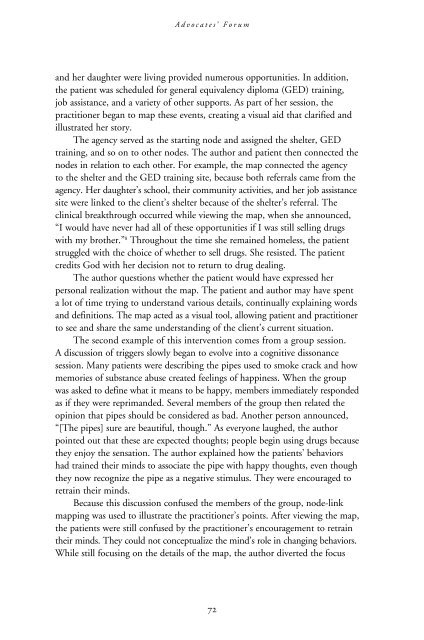2006 - School of Social Service Administration - University of Chicago
2006 - School of Social Service Administration - University of Chicago
2006 - School of Social Service Administration - University of Chicago
You also want an ePaper? Increase the reach of your titles
YUMPU automatically turns print PDFs into web optimized ePapers that Google loves.
Advocates’ Forum<br />
and her daughter were living provided numerous opportunities. In addition,<br />
the patient was scheduled for general equivalency diploma (GED) training,<br />
job assistance, and a variety <strong>of</strong> other supports. As part <strong>of</strong> her session, the<br />
practitioner began to map these events, creating a visual aid that clarified and<br />
illustrated her story.<br />
The agency served as the starting node and assigned the shelter, GED<br />
training, and so on to other nodes. The author and patient then connected the<br />
nodes in relation to each other. For example, the map connected the agency<br />
to the shelter and the GED training site, because both referrals came from the<br />
agency. Her daughter’s school, their community activities, and her job assistance<br />
site were linked to the client’s shelter because <strong>of</strong> the shelter’s referral. The<br />
clinical breakthrough occurred while viewing the map, when she announced,<br />
“I would have never had all <strong>of</strong> these opportunities if I was still selling drugs<br />
with my brother.” 8 Throughout the time she remained homeless, the patient<br />
struggled with the choice <strong>of</strong> whether to sell drugs. She resisted. The patient<br />
credits God with her decision not to return to drug dealing.<br />
The author questions whether the patient would have expressed her<br />
personal realization without the map. The patient and author may have spent<br />
a lot <strong>of</strong> time trying to understand various details, continually explaining words<br />
and definitions. The map acted as a visual tool, allowing patient and practitioner<br />
to see and share the same understanding <strong>of</strong> the client’s current situation.<br />
The second example <strong>of</strong> this intervention comes from a group session.<br />
A discussion <strong>of</strong> triggers slowly began to evolve into a cognitive dissonance<br />
session. Many patients were describing the pipes used to smoke crack and how<br />
memories <strong>of</strong> substance abuse created feelings <strong>of</strong> happiness. When the group<br />
was asked to define what it means to be happy, members immediately responded<br />
as if they were reprimanded. Several members <strong>of</strong> the group then related the<br />
opinion that pipes should be considered as bad. Another person announced,<br />
“[The pipes] sure are beautiful, though.” As everyone laughed, the author<br />
pointed out that these are expected thoughts; people begin using drugs because<br />
they enjoy the sensation. The author explained how the patients’ behaviors<br />
had trained their minds to associate the pipe with happy thoughts, even though<br />
they now recognize the pipe as a negative stimulus. They were encouraged to<br />
retrain their minds.<br />
Because this discussion confused the members <strong>of</strong> the group, node-link<br />
mapping was used to illustrate the practitioner’s points. After viewing the map,<br />
the patients were still confused by the practitioner’s encouragement to retrain<br />
their minds. They could not conceptualize the mind’s role in changing behaviors.<br />
While still focusing on the details <strong>of</strong> the map, the author diverted the focus<br />
72
















